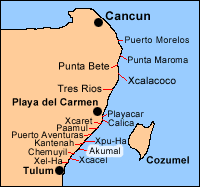Saturday, August 10, 2013
Heading for Quintana Roo, Mexico (March 22, 2013)
Image of the beach in Akumal, Mexico. Of course, I spent my time in the hot, dusty, non-beach side of town.
I've been to Mexico before--in fact, I lived there for almost five months in college--however I knew that a trip to Cancun and surrounding towns would be different from my experiences in Guadalajara. For starters, the whole area is designed almost exclusively for tourism, with dozens of high-walled "all-inclusive" resorts along the highway from Cancun to Akumal. The plane I took was filled with travelers headed for these destinations, which for me has always been nothing more than a chance to sit on a private beach and get bored while never having a chance to see what Mexico really has to offer. Visitors to these resorts can go about their days without ever speaking a word of Spanish, which for me completely defeats the purpose of heading for Mexico in the first place. This is the country where I had my first Spanish-language conversation, and it's where I learned to speak with enough facility to survive two years in Panama. People who travel to a Spanish-speaking country without ever actually bothering to learn a few words and phrases are the ones who make shake my head and sigh.
But I wasn't in Mexico to criticize the tourism industry, I was there to find spiders. Akumal (about an hour south of Cancun) was where the spiders were first reported to be vegetarian, and that's where I was headed. I'd been told that there was a stand of acacia plants (the spiders' preferred host) under high-voltage electrical towers on the inland side of town, so that's where I made my first stop.
Map source: http://www.travelyucatan.com/akumal_mexico.php
Now the host plant where Bagheera kiplingi generally lives is not a friendly-looking plant. It has definite character in its own right, however its beauty comes with inch-long, hollow spines that cover most of the branches and trunk.
Image of Vachellia collinsii, Photo source: http://commons.wikimedia.org/wiki/File:Acacia_Collinssi.JPG Note the ants and what appears to be some sort of a silken spider nest in the center.
While these thorns may have originally evolved to discourage herbivores (many acacia plants have this defense), the thorns of Vachellia collinsii and its relatives have taken this mechanism to a new level, in which highly-aggressive Pseudomyrmex ants live inside the hollowed-out structures and vigorously defend the plant from any animal that might try to nibble on the leaves. As one who has been stung by these particular ant on many occasions, I can confirm that this is a powerful deterrent to any hungry leaf-eater.
Image credit for Pseudomyrmex peperi: April Nobile of AntWeb.org
Stinging ants? You might ask. Don't they bite instead? Well, ants actually belong to the insect order Hymenoptera, along with wasps and bees. Many ant species have powerful stings, including the Central American "bullet" ant (Paraponera clavata), whose name says everything you'd ever need to know about its sting!
Image source: http://en.wikipedia.org/wiki/File:Paraponera_clavata.jpg
Thankfully, Pseudomyrmex ants aren't quite so bad as Paraponera, although I have not (yet) been stung by all of the species that inhabit acacia plants in Central America. One of them, a Panamanian species named Pseudomyrmex satanicus has a name that makes me wonder how painful the sting might be.
In addition to shelter, the ants receive food as a reward for defending their plant host. This nourishment comes in the form of nectar via small "nectaries" at the base of many leaves (which actually tastes quite good) and "Beltian bodies," or specialized leaf tips (named after Thomas Belt) that contain all of the nutrients that the ants (and their larvae) need to survive.
Nectaries on a leaf of Vachellia collinsii. The sources of nectar are the small, round structures on the right side. Image credit: http://lcarley.blogspot.com/2011/04/palo-verde-pt-4-independent-projects.html
Beltian bodies on the leaf of Vachellia cornigera, a close relative of V. collinsii. Image credit: http://en.wikipedia.org/wiki/File:A-cornigera.jpg
Bagheera kiplingi takes advantage of this system by using its keen eyesight and smart (for a spider) brain to avoid the ant patrols, stealing Beltian bodies and nectar for its own consumption. It nests directly on the plant, and studies have shown that as much as 90% of its diet comes from vegetarian sources.
Bagheera kiplingi feasting on a Beltian body. How could you not love that face? Image credit: Robert L. Curry.
Upon my arrival, I thought that acacia trees would be everywhere, and from what I thought I'd seen at the airport, I'd believed I was right. And therein lies the first mistake I made while searching for Bagheera--what appears to be the plant you are looking for can be easily misidentified.
Leucaea leucocephala, the plant I'd originally believed to be Vachellia collinsii. Note the lack of thorns.
As it turned out, finding Vachellia collinsii with Bagheera kiplingi living on it turned out to be more difficult than I'd originally believed.
Subscribe to:
Post Comments (Atom)









No comments:
Post a Comment